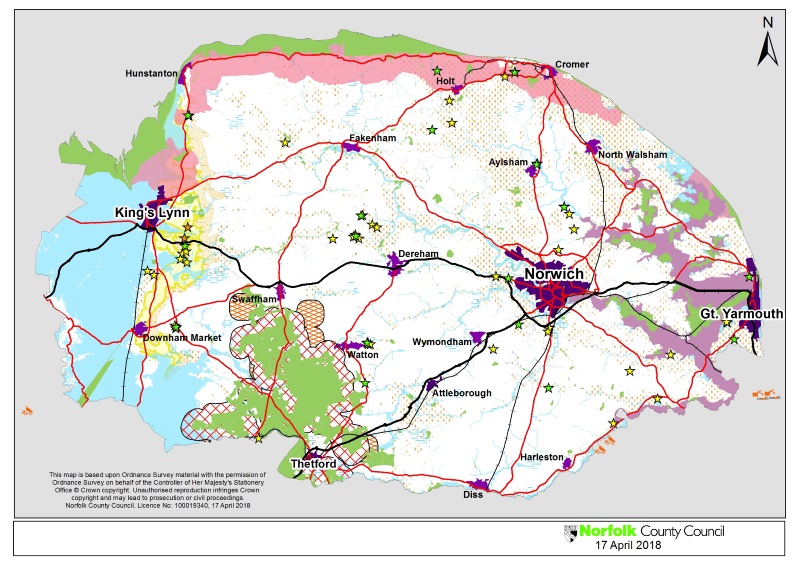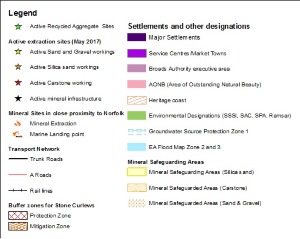Initial Consultation document
6. The Strategy – Vision and Strategic Objectives
This chapter sets out the Plan Vision and Strategic Objectives for Norfolk up to 2036. The 'Vision' sets an aspiration for minerals and waste management development in Norfolk by the end of the Plan period. From the Vision a number of 'Strategic Objectives' have been defined. These are the issues and opportunities that must be addressed in order to achieve the Vision.
|
Minerals and Waste Local Plan Vision to 2036: Norfolk will continue to be self-sufficient in the production of sand & gravel, whilst making an important contribution to the national production of silica sand. A steady and adequate supply of minerals to support sustainable economic growth will be planned for through allocating sufficient sites and/or areas in the Plan to meet the forecast need for sand and gravel, carstone, and silica sand. Resources of sand and gravel, carstone and silica sand within defined Mineral Safeguarding Areas will be safeguarded from needless sterilisation by non-mineral development. Infrastructure for the storage, handling, processing and transportation of minerals will also be safeguarded from incompatible development. All mineral workings will be covered by progressive restoration schemes and the enhancement of Norfolk's biodiversity, and the creation of high quality, locally distinctive landscapes will be strongly supported. Over the period to 2036, households, businesses, the public sector and voluntary organisations within Norfolk will be taking responsibility for waste prevention, re-use and recycling. The re-use, recycling and recovery of waste in Norfolk will increase, thereby reducing the quantity and proportion of waste arising in Norfolk that requires disposal. Norfolk will aim to be net self-sufficient in waste management, where practicable. The Plan will enable sufficient waste management infrastructure to be provided for Norfolk to meet the existing and forecast amount of waste expected to arise over the Plan period. The Plan policies will offer flexibility whilst still maintaining a Plan-led approach to the delivery of waste management facilities, in accordance with the Waste Hierarchy. New waste management facilities will be located in proximity to Norfolk's urban areas and main towns. Defined waste management facilities and water recycling centres will be safeguarded from incompatible development. Minerals development and waste management facilities will be located, designed and operated without adverse impacts on the amenity of local communities, the natural, built and historic environment, the landscape and townscape of Norfolk. Opportunities to enhance such features will be supported. Minerals development and waste management within Norfolk will be undertaken in ways that minimise the impact on climate change, and will be designed and located to reduce the risk from climatic effects, such as flooding. |
Question 1: 'Minerals and Waste Local Plan Vision' - Do you agree or disagree with the proposed Vision for the Minerals and Waste Local Plan? Do you have any comments or suggestions for alternative wording?
Draft Waste Management Strategic Objectives
WSO1. Support the prevention and minimisation of waste generation in line with the Waste Hierarchy, and where waste cannot be avoided, maximise the recovery value from waste.
WSO2. To support an increase in the proportion and the quantity of waste that is re-used, recycled and recovered within Norfolk.
WSO3. To safeguard and encourage opportunities to enhance existing waste infrastructure which provide an important contribution to waste management at sites that serve Norfolk.
WSO4. To achieve net self-sufficiency in waste management by 2036, where practicable.
WSO5. To make provision to meet the need for new waste management facilities through the inclusion of 'criteria-based' locational policies.
WSO6. To support the reduction of greenhouse gas emissions, primarily by moving waste up the hierarchy to minimise the need for landfill and by minimising waste transport and distance by locating new waste facilities as close as practicable to the origin of the waste.
WSO7. To ensure waste facilities and their proposed locations are sustainably designed, constructed and operated to reduce potential adverse effects on human health, amenity and the natural, built and historic environment.
WSO8. Recognise the importance of the waste sector in the local economy as a generator of employment and its provision of infrastructure which supports businesses and communities
The spatial strategy for waste management facilities is contained within Policy WP2 and illustrated on the key diagram.
Question 2: 'Waste Management Strategic Objectives' - Do you agree or disagree with the proposed strategic objectives for waste management? Do you have any further comments or suggestions for alternative strategic objectives?
Draft Minerals Strategic Objectives
MSO1. To provide a steady and adequate supply of aggregate minerals by identifying adequate mineral extraction sites/areas within Norfolk sufficient to meet the requirements of the Local Aggregate Assessment and safeguarding existing infrastructure.
MSO2. To provide a steady and adequate supply of industrial minerals by identifying adequate mineral extraction sites/areas within Norfolk sufficient to meet the forecast need and safeguarding existing infrastructure.
MSO3. To encourage the sustainable use of minerals by utilising secondary and recycled aggregates which will reduce the reliance on primary won aggregates and safeguarding existing infrastructure.
MSO4. To safeguard silica sand, carstone, and sand and gravel resources for future use. Avoiding unnecessary sterilisation by encouraging the extraction of minerals prior to other development taking place where practicable and using minerals in construction on the land from which they are extracted.
MSO5. To promote the sustainable transport of minerals by rail, road and water, including the safeguarding of railheads and wharfs for the import of minerals to and export of minerals from Norfolk.
MSO6. To ensure the sustainable and expedient delivery of mineral extraction while protecting people from harm, positively contributing to the natural, built and historic environments and mitigating against adverse cumulative impacts.
MSO7. To ensure potential impacts on the amenity of those people living in proximity to minerals development are effectively controlled, minimised and mitigated.
MSO8. To ensure that mineral development addresses and minimises the impacts it will have on climate change by: minimising greenhouse gas emissions during the winning, working and handling of minerals, providing for sustainable patterns of minerals transportation, and integrating features consistent with climate change mitigation and adaption into the design of restoration and aftercare proposals.
MSO9. To positively contribute to the natural, built and historic environments with high quality, progressive and expedient restoration to achieve a beneficial after use. The after use will protect and enhance the environment, including landscape and biodiversity improvements.
MSO10. To increase public access to the countryside and enhance biodiversity through enhancing the amenity value of land when restoring extraction sites.
The spatial strategy for mineral extraction is contained within Policy MP2 and illustrated on the Key Diagram.
Question 3: 'Minerals Strategic Objectives' Do you agree or disagree with the proposed strategic objectives for minerals? Do you have any further comments or suggestions for alternative strategic objectives?
Key diagram MW review


